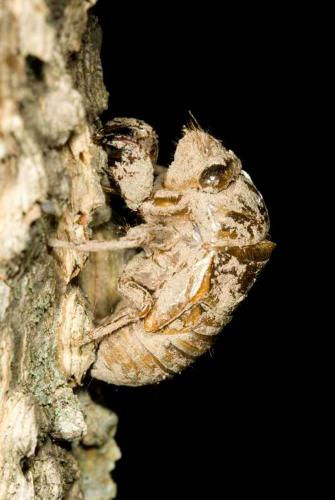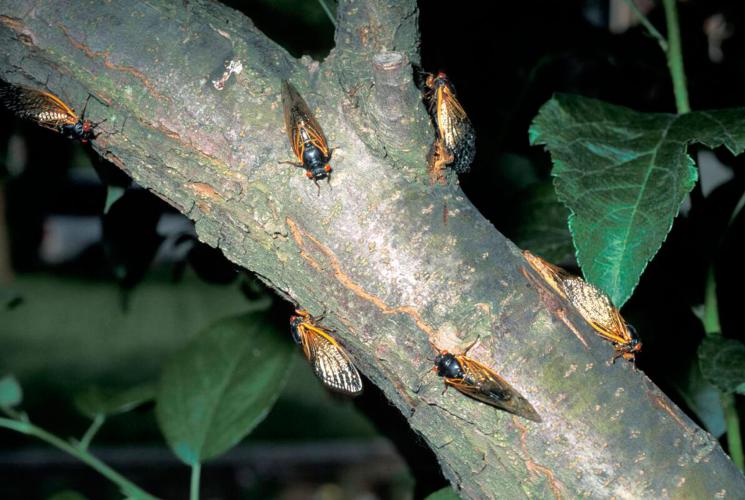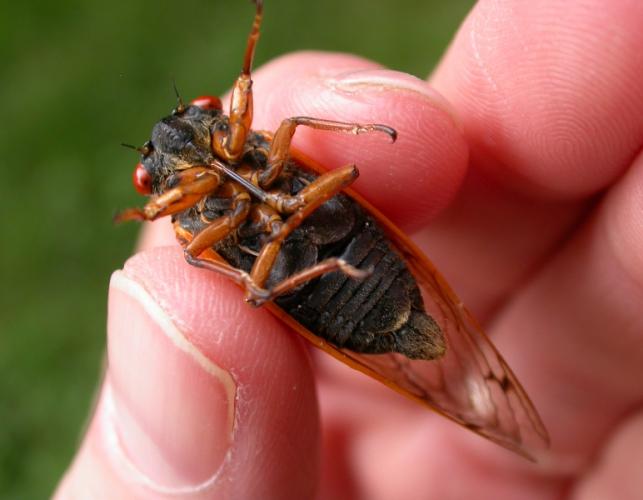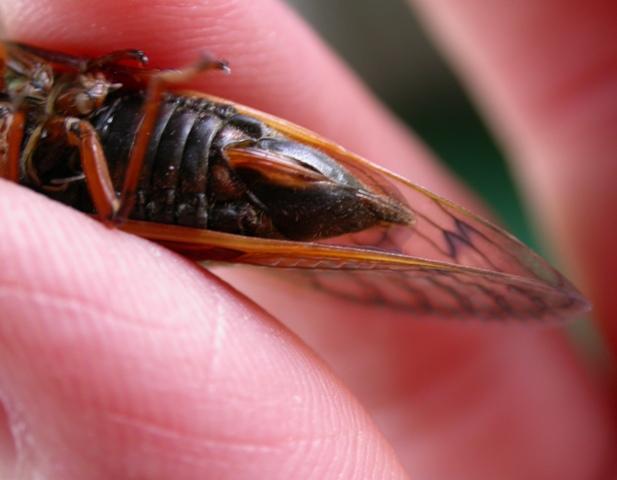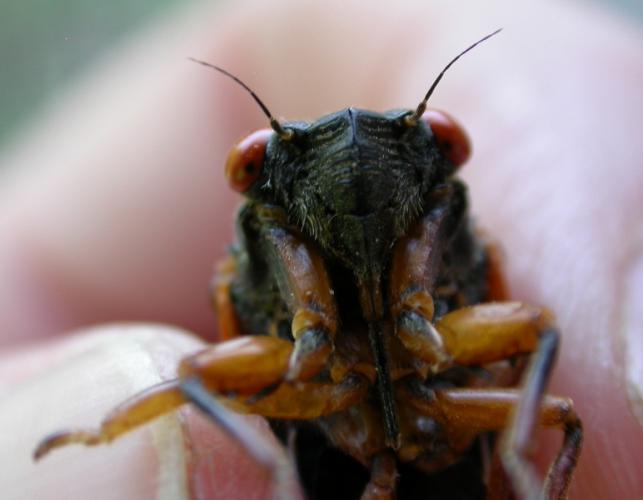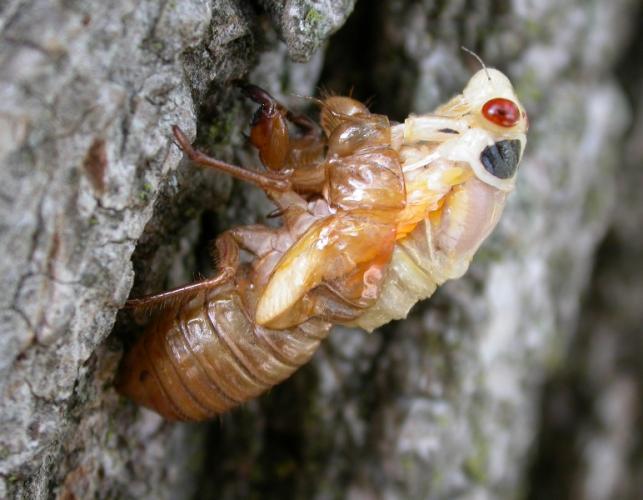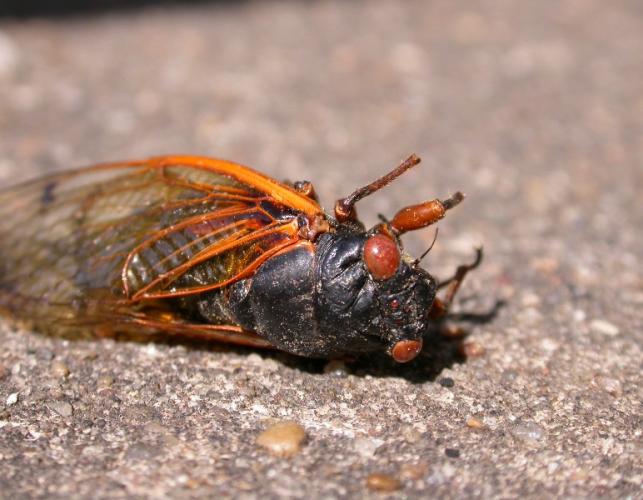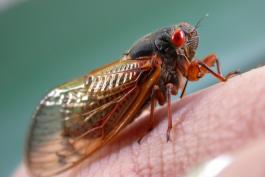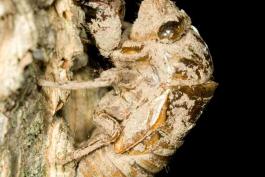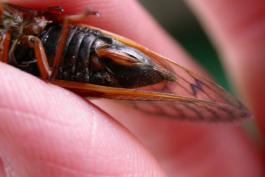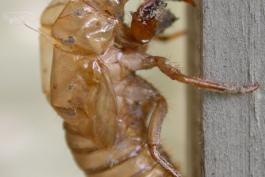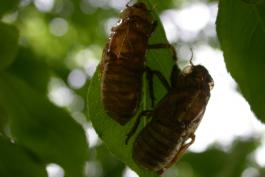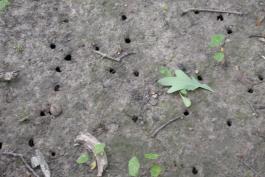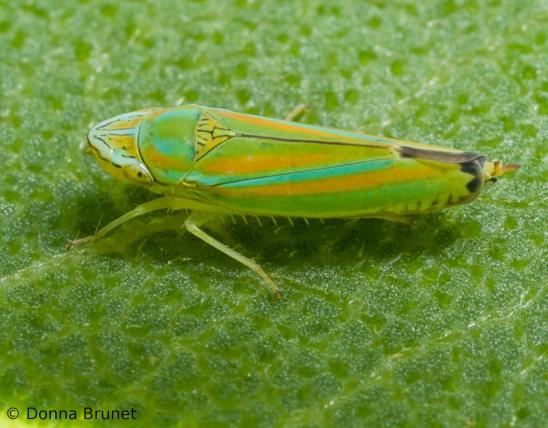
Adult periodical cicadas have blackish bodies, red eyes, and 4 membranous wings with a gold, orange, or red tinge. They crawl and fly, but they do not jump. The mouthparts, tucked beneath the head, are like a small, sharp straw. The antennae are short, and there are 3 ocelli (eyespots) in addition to the 2 larger, compound eyes. Compared to annual or “dog-day” cicadas, periodical cicadas are smaller.
Adult males have a sound-producing organ that emits a loud, raspy call used to attract females. Adult females have a curved ovipositor at the lower end of the abdomen, used to insert eggs into slits in twigs.
Nymphs are tan or brownish, wingless, stout, with the front pair of legs specialized for burrowing in the soil and for clinging onto trees as they undergo their final molt into adults. Neither nymphs nor adults are capable of harming people.
When is the next appearance of periodical cicadas in Missouri? Brood XIX (19) will emerge in May and into June of 2024. It comprises 4 species of 13-year cicadas. We last saw this brood in 2011. This brood is sometimes called the Great Southern Brood because it occurs throughout much of the southeastern United States, including 15 states. The brood's range includes much of Missouri, southern Illinois, and Arkansas, east to Virginia, North Carolina, and Georgia, and south to Louisiana, Mississippi, and Alabama.
You'll see this in the news: about the same time that Brood XIX emerges in spring of 2024, Brood XIII (13) will be appearing in parts of Iowa, Wisconsin, northern Illinois, northwestern Indiana, and perhaps the southern edge of Michigan. Brood XIII, called the Northern Illinois Brood, is a brood of 17-year cicadas. Brood XIII, however, probably will not overlap geographically with Brood XIX, so the only periodical cicadas Missouri will have in 2024 are members of Brood XIX. Cool fact: the last time these broods emerged the same year was in 1803, when Thomas Jefferson was president, the year the Louisiana Purchase was signed!
Length: to 1½ inches.

Statewide, but different broods emerge in different regions during different years.
Habitat and Conservation
Periodical cicadas make a sudden, massive appearance, usually in areas with trees, with loud raspy choruses and a multitude of shed skins left behind on tree trunks.
Food
Like most true bugs (hemipterans), cicadas have mouthparts like small, sharp straws. The nymphs live underground and suck sap from the roots of trees and other plants.
Adults can suck plant juices, too, but they live for only a few weeks above ground.
It is rare but possible that if you let a cicada sit quietly on your hand or arm for a long time, it may jab you with its mouth, mistaking you for a plant — a painful but harmless accident, and certainly not an act of aggression or even defense.
Status
Common throughout the state, but especially in areas where trees are abundant and soil left relatively undisturbed for 13 or 17 years. Because the nymphs live underground, suck juices from plant roots, and then must crawl out of the ground, large earthworks, deforestation, insecticides, enormous paved parking lots, and residential and commercial developments can decrease populations locally. Different broods in different regions each have their own schedule.
Life Cycle
The different species and broods of periodical cicadas all have a life cycle similar to annual cicadas, except instead of living as nymphs for 2–5 years underground, with some adults emerging every year, the broods of periodical cicadas live underground for either 13 or 17 years, and all of the same type in an area emerge to become adults the same year — in fact, the same week.
One trigger for emergence is when the soil temperature (as measured 8 inches below the surface) reaches 64 F. This often occurs after a nice warm soaking rain, usually in May, but possibly as early as late April or as late as early June.
How in the world do the underground nymphs know when 13 or 17 years have elapsed? Scientists are still trying to learn how cicadas synchronize their life cycles (over so many years!) so exactly. One possible explanation is that the nymphs' bodies may sense seasonal changes in the chemical composition of the tree juices they consume from roots, especially in the spring when trees leaf out. A kind of molecular clock in the cicadas is triggered by each leaf-out period, and once it's been triggered 13 or 17 times, the nymph will emerge the next time the soil warms to the emergence-trigger temperature.
Corroborating this idea is an instance in 2007 in Ohio, when many cicadas emerged a year early: the area had experienced prematurely warm January temperatures that caused many trees to bud out early, but then got zapped by a hard freeze in February and had to leaf out again that spring. The two leaf-outs apparently triggered the cicadas' molecular clocks, which counted it as two "years."
Indeed, it is not uncommon for occasional "stragglers" to emerge in the few years before and after an emergence. In years when we're getting close to a big emergence, listen for individual periodical cicadas singing in late April through early June; there's a good chance you're hearing insects whose internal clocks got fooled somehow. Keep in mind that annual cicadas don't emerge that early in the season.
When will Missouri see periodical cicadas again? Here are some predictions. Remember that the different broods may be present in some parts of Missouri but not in others.
- Brood XIX (19) should emerge in 2024. It comprises 4 species of 13-year cicadas.
- Brood XXIII (23) should emerge in 2028. It comprises 4 species of 13-year cicadas.
- Brood III (3) should emerge in 2031. It comprises 3 species of 17-year cicadas.
- Brood IV (4) should emerge in 2032. It comprises 3 species of 17-year cicadas.
Human Connections
Periodical cicadas, like gigantic mountains, big rivers, and tremendous oceans, are great wonders of nature. They make a dramatic impact on our senses. Some people dislike the incessant din of calling males, while others are impressed by it. The overall chorus has been described as sounding like "cool UFO movie soundtrack sounds."
It is pretty much useless to try to control cicadas with insecticide sprays; for the few weeks the adults are around, they are basically everywhere, since they can fly. You can try protecting small trees by hosing away the insects with water, wrapping foil or sticky insect-barrier tape around the trunk, or covering the tree with netting.
Keep in mind that cicadas are not venomous; they do not sting and only rarely, accidentally, could poke you with their mouthparts.
Many human cultures have myths based on cicadas, and many people worldwide eat cicadas, too.
Ecosystem Connections
Periodical cicadas provide a temporarily huge, but not a perennial food source for their many predators.
The slits made in twigs by thousands of egg-laying females weaken branch tips, which often break off, providing a natural 13- or 17-year pruning mechanism. Young trees may be killed, however.
Birds feast on the plentiful cicadas and are probably the reason for their odd, simultaneous, abundant appearance. The huge numbers of cicadas overwhelm their predators’ ability to eat them up, so any individual cicada has a good chance of surviving and reproducing.
Cicadas that live long enough to succumb to old age, poetically enough, end up nourishing the soil, which was their “childhood home” for 13 or 17 years.
People often don't think about the great, cumulative importance of insects and other burrowing animals when it comes to aerating and mixing soil, and how their tunnels permit rainwater to soak into the ground. Cicadas remind us of the great amount of life that occurs in the soil beneath our feet.


